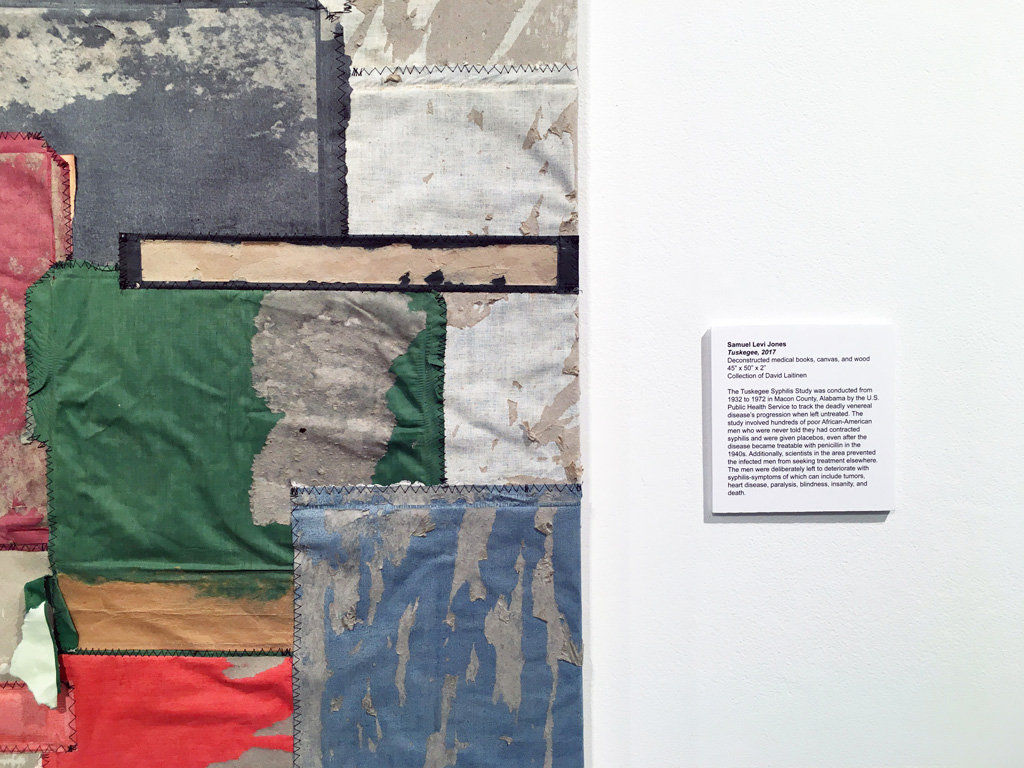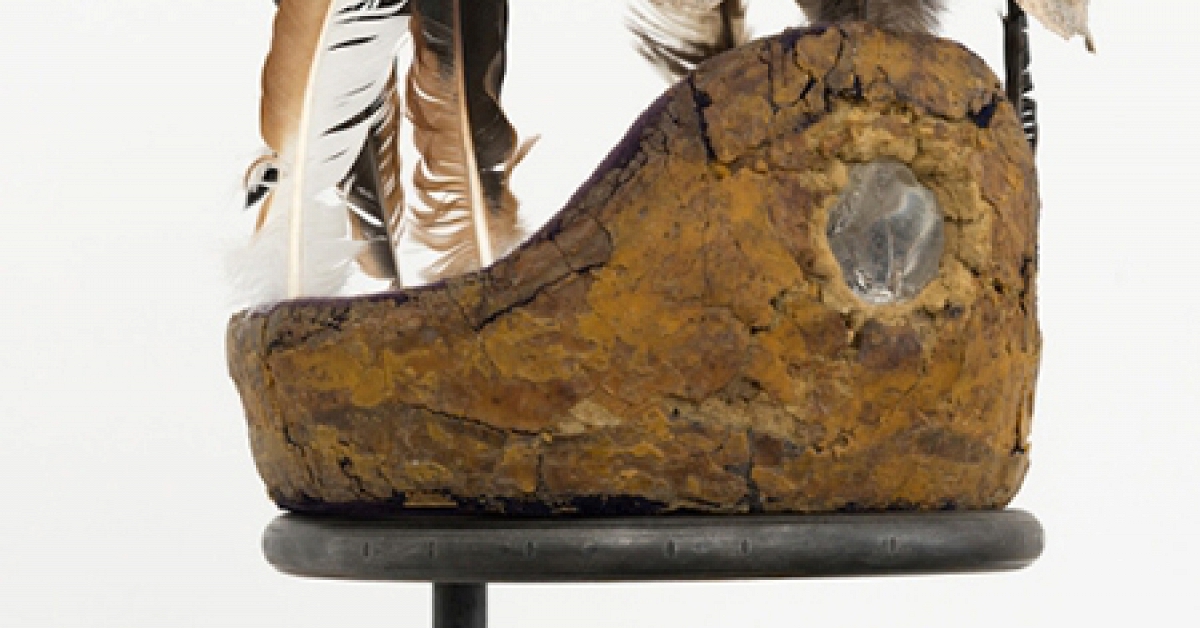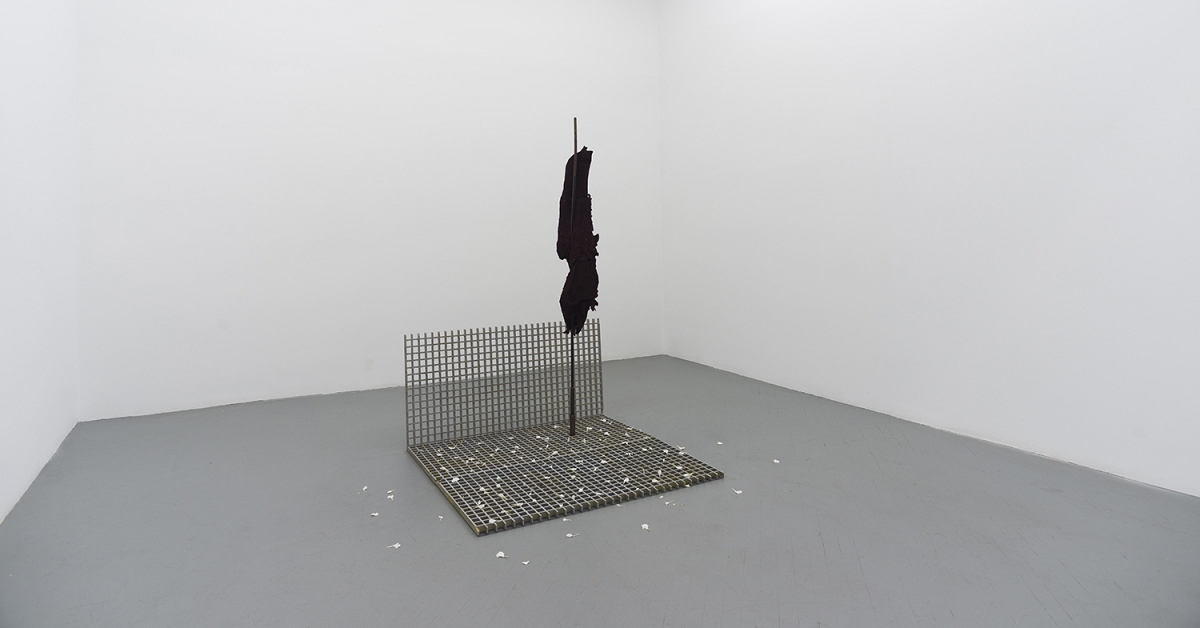Deconstructing History with Herron Alumnus Samuel Levi Jones
/ Aug 11, 2017 / Go to Original
Samuel Levi Jones (B.F.A. Photography ’09) is a rising star in contemporary art, having captured nationwide attention from galleries, museums, and art critics.

By deconstructing historical texts, the Chicago-based artist reimagines new works as patchworked paintings and installations to challenge people’s perceptions of authority, exclusion, and equality.
In 2014, Jones won the Joyce Alexander Wein Artist Prize, an annual award honoring emerging or mid-career African-American artists. More recently, Jones showed his first solo exhibition with Galerie Lelong in New York City, and worked on a project with Paulson Fontaine Press Residency in Berkeley, California. His pieces can be found in permanent collections of the San Francisco Museum of Modern Art (SFMOMA), Los Angeles County Museum of Art (LACMA), and the Studio Museum in Harlem, New York.
Below Jones shares insights into his ideas and artistic practice as well as his vision for “Remedial Suffering,” a solo exhibition on view at Herron Galleries through September 2.
HERRON: What concepts or underlying themes are behind the work in “Remedial Suffering?”
SAMUEL LEVI JONES: My wife’s uncle is a retired orthopedic surgeon. I have known him for almost twenty years now, so he is familiar with how my work has progressed from learning black and white photography to what it has become today. Through a conversation, we discussed the Tuskegee study and other maltreatment of people as a means to help, or supposedly help, people as a whole. The result of the conversation was he commissioned me to make works from his personal medical books that he had used over the years. The titles do indeed lead the viewer to the stories behind the conversations we have had.
HERRON: Calling attention to social injustices and the subjective nature of “history” seems to be a key motive of your art practice.
JONES: Calling attention to the struggle is a means of grappling with or surviving the past in the present, and what feels like will be an ongoing maltreatment of the other.
HERRON: How do you decide which books to use as source material, and where or how do you track them down?
JONES: The choice of material typically comes from subject matter — initially encyclopedias, then law books, and most recently medical books. The decision to use encyclopedias was a result of thinking about histories and narratives left out of standardized resource material. Much of my material has been sourced via Craigslist. These books tend to be the least expensive.
HERRON: Do you consider the physical process of breaking down books as part of the artwork itself?
JONES: There definitely is something about the labor that is inseparable from the work. I played several different sports in my youth. Football was the main sport with which I participated, and physical labor was always part of preparation. The effort toward the labor is a result of the interest. I believe I have groomed myself to have labor always be part of what holds my interest.
HERRON: On a similar note, do you consider the finished pieces to be paintings or something else entirely?
JONES: I refer to the works on canvas as paintings even though they hold no paint. Sometimes these works become large installations. But I am most interested in the way the objects may or may not move the viewer to think about the subject matter than I am with labeling them a particular medium.
For me, Herron was … a time where I was able to find myself and connect it to my making.
HERRON: How are you hoping audiences will engage with your work?
JONES: In the use of medical books, I am considering ways in which the human race could see a common struggle. In the current political climate, we are dealing with a situation related to the wellbeing of our bodies, which are 99.9% alike, but somehow, we continue to be manipulated by the 0.01% difference. It is the focus on difference that harms all of us.
HERRON: What future projects or exhibitions do you have lined up?
JONES: I will soon be revisiting materials related to my early years of labor in an exhibition at Patron Gallery in Chicago, March 2018. The exhibition will include works made from footballs.
HERRON: What advice would you give to Herron students about thriving as visual artists in the world of contemporary art?
JONES: Firstly thrive within thyself, and secondly “the world.” The contemporary art one makes should become you, not you it.

By deconstructing historical texts, the Chicago-based artist reimagines new works as patchworked paintings and installations to challenge people’s perceptions of authority, exclusion, and equality.
In 2014, Jones won the Joyce Alexander Wein Artist Prize, an annual award honoring emerging or mid-career African-American artists. More recently, Jones showed his first solo exhibition with Galerie Lelong in New York City, and worked on a project with Paulson Fontaine Press Residency in Berkeley, California. His pieces can be found in permanent collections of the San Francisco Museum of Modern Art (SFMOMA), Los Angeles County Museum of Art (LACMA), and the Studio Museum in Harlem, New York.
Below Jones shares insights into his ideas and artistic practice as well as his vision for “Remedial Suffering,” a solo exhibition on view at Herron Galleries through September 2.
HERRON: What concepts or underlying themes are behind the work in “Remedial Suffering?”
SAMUEL LEVI JONES: My wife’s uncle is a retired orthopedic surgeon. I have known him for almost twenty years now, so he is familiar with how my work has progressed from learning black and white photography to what it has become today. Through a conversation, we discussed the Tuskegee study and other maltreatment of people as a means to help, or supposedly help, people as a whole. The result of the conversation was he commissioned me to make works from his personal medical books that he had used over the years. The titles do indeed lead the viewer to the stories behind the conversations we have had.
HERRON: Calling attention to social injustices and the subjective nature of “history” seems to be a key motive of your art practice.
JONES: Calling attention to the struggle is a means of grappling with or surviving the past in the present, and what feels like will be an ongoing maltreatment of the other.
HERRON: How do you decide which books to use as source material, and where or how do you track them down?
JONES: The choice of material typically comes from subject matter — initially encyclopedias, then law books, and most recently medical books. The decision to use encyclopedias was a result of thinking about histories and narratives left out of standardized resource material. Much of my material has been sourced via Craigslist. These books tend to be the least expensive.
HERRON: Do you consider the physical process of breaking down books as part of the artwork itself?
JONES: There definitely is something about the labor that is inseparable from the work. I played several different sports in my youth. Football was the main sport with which I participated, and physical labor was always part of preparation. The effort toward the labor is a result of the interest. I believe I have groomed myself to have labor always be part of what holds my interest.
HERRON: On a similar note, do you consider the finished pieces to be paintings or something else entirely?
JONES: I refer to the works on canvas as paintings even though they hold no paint. Sometimes these works become large installations. But I am most interested in the way the objects may or may not move the viewer to think about the subject matter than I am with labeling them a particular medium.
For me, Herron was … a time where I was able to find myself and connect it to my making.
HERRON: How are you hoping audiences will engage with your work?
JONES: In the use of medical books, I am considering ways in which the human race could see a common struggle. In the current political climate, we are dealing with a situation related to the wellbeing of our bodies, which are 99.9% alike, but somehow, we continue to be manipulated by the 0.01% difference. It is the focus on difference that harms all of us.
HERRON: What future projects or exhibitions do you have lined up?
JONES: I will soon be revisiting materials related to my early years of labor in an exhibition at Patron Gallery in Chicago, March 2018. The exhibition will include works made from footballs.
HERRON: What advice would you give to Herron students about thriving as visual artists in the world of contemporary art?
JONES: Firstly thrive within thyself, and secondly “the world.” The contemporary art one makes should become you, not you it.






